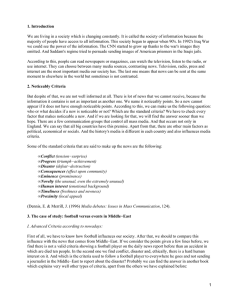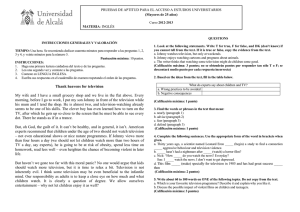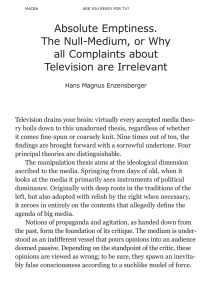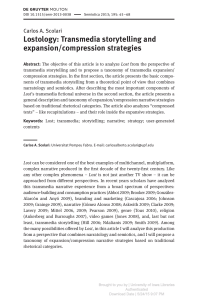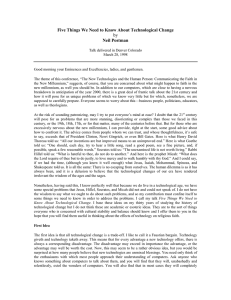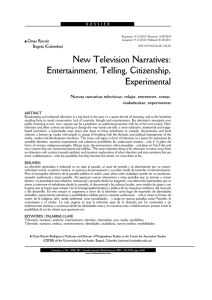Transmedia audiences and television fiction: A
Anuncio
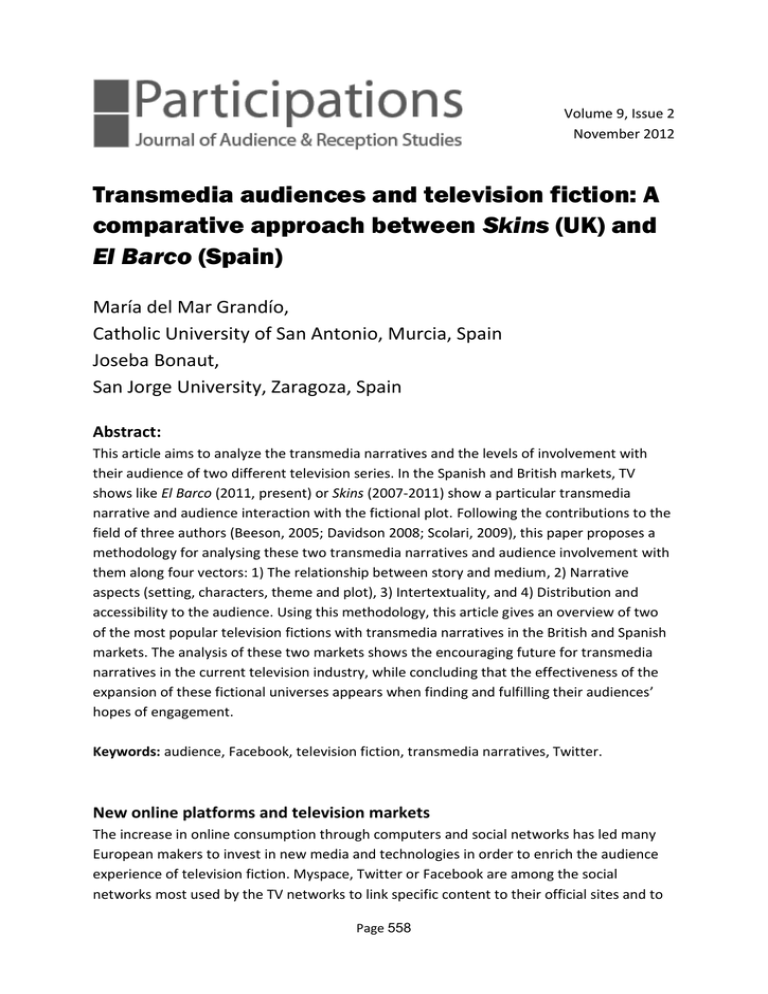
. Volume 9, Issue 2 November 2012 Transmedia audiences and television fiction: A comparative approach between Skins (UK) and El Barco (Spain) María del Mar Grandío, Catholic University of San Antonio, Murcia, Spain Joseba Bonaut, San Jorge University, Zaragoza, Spain Abstract: This article aims to analyze the transmedia narratives and the levels of involvement with their audience of two different television series. In the Spanish and British markets, TV shows like El Barco (2011, present) or Skins (2007-2011) show a particular transmedia narrative and audience interaction with the fictional plot. Following the contributions to the field of three authors (Beeson, 2005; Davidson 2008; Scolari, 2009), this paper proposes a methodology for analysing these two transmedia narratives and audience involvement with them along four vectors: 1) The relationship between story and medium, 2) Narrative aspects (setting, characters, theme and plot), 3) Intertextuality, and 4) Distribution and accessibility to the audience. Using this methodology, this article gives an overview of two of the most popular television fictions with transmedia narratives in the British and Spanish markets. The analysis of these two markets shows the encouraging future for transmedia narratives in the current television industry, while concluding that the effectiveness of the expansion of these fictional universes appears when finding and fulfilling their audiences’ hopes of engagement. Keywords: audience, Facebook, television fiction, transmedia narratives, Twitter. New online platforms and television markets The increase in online consumption through computers and social networks has led many European makers to invest in new media and technologies in order to enrich the audience experience of television fiction. Myspace, Twitter or Facebook are among the social networks most used by the TV networks to link specific content to their official sites and to Page 558 Volume 9, Issue 2 November 2012 generate an interaction between viewers and the fictional characters. In the current television landscape, serialized fiction has taken on special significance as one of the most popular audiovisual forms for audiences. The quality of some of these productions offers considerable prestige to the television companies, and many are already real flagships for their networks and production companies. For example, many characters in popular TV series now have a personal account on Twitter, Facebook or Myspace, and it is also common to find characters’ videoblogs, in which they explain their feelings about what is happening in the main television plot (all marked by the TV script writers). The past ten years have seen a revolution in the ways of watching TV, mainly due to the influence of the Internet and social networks, and the emergence of mobile devices through which you can watch video content (tablets, smartphones ...). The new model of television fiction, created in the United States and exported to the rest of the world, has had two major repercussions: the modification of values in the major television networks’ storytelling model; and the creation of a more active audience, congruent with new generations and the intervention of technology (Hellekson and Busse, 2006). The sum of these factors has enabled a new understanding of the relationship between television as a medium and the public, in addition to a new way of seeing television (prolongation and reformulation of the fiction story). We face a form of viewing in which spectators, increasingly connected to the network, can consume TV content on demand, while initiating discussions on this material through their usual social networks: in other words, social television. This was manifested as industry reports published in 2011 called Televidente 2.0, which reveals how tablets, connected TV and social networks enrich the consumer TV scenario (The Cocktail Analysis, 2011). In this context, TV shows are one of the main forms which have increased their visibility on the Web by incorporating specific strategies into their narratives on social networks like Twitter, Myspace or Facebook, thereby facilitating the integration of viewers within these stories. Transmedia storytelling and television fiction After the significant developments experienced in the 1990s, the last decade has been crucial for the narrative and formal frameworks of fiction programmes, which critics and public alike have defined as the most daring and interesting in the world of television entertainment. In this context, the most interesting phenomenon has been the creation of new narrative strategies adapted to a new audience that not only consumes fiction on television, but also through new communication networks. Transmedia storytelling is the expansion of the same fiction through different media platforms so that “each franchise is self-sufficient to allow its individual consumption” (Jenkins, 2003: 3). Regarding television fiction, as Staffans explains, “this can be done in many ways; through characters in blogs, through exciting and engaging television drama series, through SMS, Twitter, Facebook, apps … the key is to create the stories and the world, and use the platforms that come naturally to the different parts of the story” (2011: Page 559 Volume 9, Issue 2 November 2012 7). As Buckner and Rutledge explain, there are three reasons why producers should be using transmedia storytelling to make their audiovisual stories more successful: persuasion, audience connection, and financial impact. Regarding audiences, “transmedia strategies create many points of entry that reach and link multiple demographics and target different user needs to effectively expand the customer base (2011)”. Each media piece – whether it’s a comic, novels, video games, mobile apps, or a film – “functions as a standalone story experience – complete and satisfying” for the audience (Buckner and Rutledge, 2011). The TV networks began to realise (and continue to do so) that they had to understand the consumption of television fiction as a cross-platform practice. Traditional broadcasting was just one element of this, meaning that networks had to strengthen their ties with the public (and naturally also commercial ties) through new communication networks. Consequently, they developed new strategies which focused on prolonging the story as a commercial item. First, TV networks used their official online websites to offer full episodes after they were aired (the ABC network was the first to do this, with new advertising inserts). Second, they increased fans’ expectations by offering exclusive material about the programme through different routes. The case of Lost (ABC, 2004-2010) serves as a model (Wyatt, 2007). It provided recapitulation videos for each season, weekly previews of the forthcoming episodes, special episodes (both for TV and Internet) where details of plots were explained or added, exclusive Internet episodes that broadened the experiences of characters and stories (webisodes), and virtual games that developed parallel stories and which required viewer participation (Lost Experience) (Porter and Lavery, 2010). Third, the series’ makers used the Internet and its various media (mainly forums) to give advance information about content, and to increase public expectation by “leaking” the first episodes of the season or “pilot” programmes for new series. While it is now a common phenomenon, the series 24 (FOX, 2001-2010) pioneered this by showing the first four episodes of its sixth season one week before they were first aired. These episodes, known as pre-air episodes, did not reduce the audience for the programme, rather, they increased interest in it. 24 also paved the way for narrative experimentation by creating exclusive episodes between seasons that filled the gaps that existed between the different moments in Jack Bauer’s life as portrayed in the programme: first with an exclusive episode for the Internet between the fifth and sixth seasons and, later, with a film-length (90-minute duration) episode made for the series called 24: Redemption (FOX, 2008), which whetted appetites for the programme’s seventh season (Hanks, 2008). Fourth, within new textual forms, Twitter has become a key communication tool for narrative expansion of a television fiction. Under a crossmedia strategy, characters of successful TV series create their own Twitter accounts to generate a parallel plot through tweet-peats and Twittersodes (tweets + episode). NBC’s TV comedy Community debuted with a Twittersode just prior to the broadcast comedy’s episode on 23 September 2010. As its press release said, “over the Page 560 Volume 9, Issue 2 November 2012 course of 80 tweets, the characters communicate back and forth in what’s described as a ‘prequel’ scene to their return to Greendale Community College as sophomores” (Bierly, 2010). All these transmedia strategies also have an impact on the marketing and promotion of the TV series, as happened with Lost (Ramos-Serrano and Lozano-Delmar, 2001), or True Blood (Rodríguez, 2011), to name just two. In this respect, British fiction (with channels E4 and Channel 4 at the fore) has also introduced an innovative way of creating these television products, bringing them closer to younger audiences through a strategy of including more provocative and controversial subjects, and by extending the story beyond the realm of television broadcasts (via social networks, Internet forums, videoblogs and text messaging, among others). Regarding the Spanish market, in a study analyzing the visibility of the television series on the Web in Spain, Elena de la Cuadra and Maria Victoria Nuñoz highlight how “the achievements of the television channels on the Internet are incalculable from the perspective of the user and the content”; however, they underline that “the quantity and quality of information offered by television websites in Spain is insufficient and imprecise” (2010: 661). As Scolari suggests, fictional transmedia productions are taking their first steps into the Spanish market, and it is no accident that the professional parts of the sector are looking at the productions coming from the USA and the UK for inspiration (2012: 161). The study of these successful transmedia narratives (Skins and El Barco) reinforces the idea that the TV fans gets involved into these multiplatform stories, cultivating viewers’ loyalty and the creation of community. As scholars have pointed out, “in our present epoch, social networks are fast becoming the main field of promotion and user engagement for audiovisual products. Hence this kind of campaign suggests to us the necessity of reconsidering the idea of text as part of a wider user experience, rather than as a finished, completed product” (Zaccone, 2011: 387). Methodology As Álvarez Berciano writes, “the phenomenon of transmedia narrative, as a result of the experimentation of the fiction in television in a multiplatform and multimedia scenario, raises multiple challenges which not only affect the decisions of the industry, but also the academic reflection and analysis, which establish new forms as objects of study” (2012: 33). Bearing this in mind, this article proposes a methodology for the analysis of effectiveness of transmedia storytelling and involvement of audiences (the correct and creative expansion to other platforms from the original story searching for audience’s interaction) within this new parading of connection. From a transmedia perspective, a narrative is a group of stories that has a center of origin, a basic product which is then developed in different media languages. In a transmedia narrative, each product is an effective window into the whole story. All these new means of communication are creating a new way of consuming fiction series in line with a new viewer and new storytelling model for television series. Page 561 Volume 9, Issue 2 November 2012 Following the contributions to the field of three authors (Beeson, 2005; Davidson 2008; Scolari, 2009), four levels of analysis have been systematized. We should clarify in advance that this empirical study has differentiated between the “central story” (or source series which represents the mother or primary narrative) and the “derived narrative” (the story or product that is designed from the central story for other platforms). The result is essentially a macro-narrative, a mega-text, with a coherent unity among all their pieces. Audiences delve into this multi-content, turning into “transmedial consumers” (Scolari, 2009: 597), who are more involved than those others whom we can call “unimodal consumers”. 1) Story -------- Medium 2) Narrative aspects Television Novels Official website Videomeetings Facebook Twitter Online games Activities offline Parties… Characters Plot Settings Topic 3) Intertextuality 4) Accessibility and involvement with viewers Centrality of all the stories together and independence of each one Levels of audience involvement with the story (accessibility, participation and engagement) Table 1: Summary of the proposed methodology for the analysis of a transmedia narrative. Own elaboration. Designed and developed from the methodologies of Beeson (2005), Davidson (2008) and Scolari (2009), the explanations of these four vectors are as follows: 1. Relations between the central story and the medium or format selected for the derivative story. Exploring the language (audiovisual, print, interactive…) of the media or format of the derived story is given especial attention. Page 562 Volume 9, Issue 2 November 2012 2. Narrative aspects of the main story and the derived ones. Using a combination of classical textual analysis and attention to the basics of the script-writing process, this methodology analyses the plot, the characters of the story, setting and theme. 3. Intertextuality: this means the analysis of the narrative connections between the original and the derived story. The concept of intertextuality is closely linked with transmedia narratives. Intertextuality is “the set of relations that link one text with another of different sources” (Guarino, 2007) and leads, by its evolution through Genette’s (1989) concepts such as architextuality and transtextuality, into intertextuality (Eco, 1988, Barthes, 1957) and intermediality (Plett, 1991). For this study, this means the analysis of the internal and narrative connections among the cross-media stories altogether. 4. Accessibility and involvement of the viewers within the derived stories. In this analysis, we pay special attention to the levels of involvement between derived narratives and those receiving them, analyzing their accessibility to viewers (access to the new platforms and usability), involvement (in terms of participation and interaction with the stories) and finally engagement (creation of a fandom). Regarding social networks, that’s to say the number of followers on Twitter or fans on Facebook, the interaction with the viewers through comments, and with the fan community on Twitter through replies or retweets. Transmedia analysis: the case of Skins (2007-2012) and El Barco (2011-2012) Skins and El Barco are presented as a model adapted to the needs of “new television” and, consequently, their success has moved beyond audience share, to reach a number of platforms for multiple forms of consumption. Their ultimate goal was to link the new reality of audiovisual consumption with the dramatic construction of fiction while cultivating viewer loyalty. Skins and El Barco are both targeted at a young audience. To give a general introduction to the two TV series: Skins (2007-2012) is a British TV fiction broadcast by E4 which talks about the daily lives of young men from Bristol, who have to face a reality that does not satisfy them, including imperfect education and broken families. The show’s themes focus on controversial issues such as sex, drugs, sexual orientation or anorexia, causing considerable controversy in the UK and even the cancellation of MTV’s U.S. remake. Meanwhile, El Barco (2011-2012) is a Spanish TV series on Antena 3 channel which tells the story of the ship Estrella Polar and its crew. Forty-two young people have set off for two months to meet and fall in love. But everything changes when they try to return to land after a powerful storm. The ship manages to stay afloat thanks to the work of the entire team, but all systems are damaged. As a result, a scientist onboard begins to investigate the phenomenon and reports his initial findings, which suggest that they may have become the only inhabitants left on the planet. The main goal of the Estrella Polar’s survivors will be to come back home, wherever that may be now. Page 563 Volume 9, Issue 2 November 2012 These two television fictions are developed and analysed in the following media and platforms, beyond the television episodes in which the main story told: El Barco X X X Skins X X TV episodes Official Website Videomeetings with the actors Videoblogs X Webisodes (Unseen) X Gamer and/or bloggers parties (offline) X X Episode clips X X Interactivity activities X X Novels X Facebook X X Twitter X X Twittersodes X Official online game X Table 2: Transmedia storytelling and platforms (El Barco-Skins). Authors’ elaboration. Relationship between storytelling and media Skins and El Barco expand their fictional world through different languages (interactive, audiovisual, and iconic) and media (TV broadcasting, novels, social networks, video blogs…). The creators and scriptwriters of the two TV series create a multimedia story altogether and explore what each medium can do best to add value to the main story. The actual TV broadcasting still remains the main reference point of the storytelling for the viewer, but interactive media offer a deeper approach to these fictions’ complex worlds: adding new values to the TV story and creating new plots that cultivate consumer loyalty. These actions are not improvised. They are the result of a real multi-platform narrative strategy searching for audience involvement. Therefore, we can consider both shows as excellent examples of new creative storytelling not only for television (referential story) but especially for new media: Twitter, Facebook, webisodes, videoblogs, interactive experiences, and so on. In the case of Skins, the use of videoblogs by the main characters adds intimacy and closeness to the viewer, together with new insights from the characters not seen on TV. The show’s characters act and interact with the audience via video-diaries (videoblogs), talking about what they have experienced in previous episodes and how they felt at that time. These videoblogs have regularly generated content (videos, photos, music) that advanced aspects of the plot and encouraged interest from an audience who were becoming true fans. This extension of the story is key in off-season periods, as this is when viewers might forget or “disconnect” from the series. Also, the short webisodes, as they are shorter in duration than the TV episodes, can be consumed as little pills of the story, keeping the Page 564 Volume 9, Issue 2 November 2012 audience satisfied in those periods when the TV show is not on. In the case of El Barco, the use of Twitter could involve the audience with the plot before it was even broadcast. The characters of El Barco have their own Twitter accounts and all together generate twittersodes prior to the broadcast episodes every week. With specific language features (immediacy, and simultaneity on live, 140 characters in each tweet, the use of hashtags to generate a conversation with the fans, etc), Twitter generates a collective and participatory consumption. Analysis of narrative issues Narratology, from a transmedia perspective, has a clear goal: to distinguish the story (object) from how “it is told” (language and medium) (Beeson, 2005: 1). In order to examine this object and its transformation through a transmedia narrative, we expand the analytical method of Davidson (2008), inspired by his perspective, using four elements to define the narrative perspective of a story: theme and plot, configuration (space and time), characters, and intertextuality. Theme and plot The thematic approach of Skins and El Barco fits perfectly with the use of alternative media, and its combination with TV storytelling. Skins always works with concepts like exclusivity and complicity, where characters’ personal issues are shared through videoblogs and social networks. In the case of the Spanish TV fiction, the plot of El Barco begins when an incredible storm leaves the ship “Estrella Polar” lost in the middle of the ocean. In addition to this event and while the survivors try to go back home again, life on the ship continues to develop. Stories of love, jealousy and hatred unfold as time goes by. The two series were also able to combine the possibilities offered by the combination of a teen genre (relationships between characters, continuity of the plot through a soap opera-like model, highly pronounced social stereotypes and standardised themes) with other very different genres (science fiction, horror, musical, etc.). Configuration of space and time Configuration defines narrative context: the space and time of the story, or, where the story takes place and its time-dimension. We find these processes at work in our case studies. With Skins, the TV storytelling has the ability to show unique spatial spheres for each character. Here, we can define four main references: Personal sphere: home and family. Private sphere: their bedroom (their intimate world). Public sphere: school or work. Social sphere (relationships): leisure areas and parties. Page 565 Volume 9, Issue 2 November 2012 In the case of El Barco, the defining space is the ship. So, the characters combine the personal and public sphere within the same overall space but in different rooms. They use the canteen and their own bedrooms to express their intimate world. All storytelling strategies in both shows go through these spheres, with more or less intensity. However, with regard to wider media use, some media are more suited to showing private spheres, such as those related to the Internet: videoblogs, Twitter, Facebook or webisodes. These media create a direct relationship between the characters and the viewers. They choose what they want to show, how and to whom. It’s better to tell an intimate story or a confession through interactive media (ie. videoblogs in the case of Skins and Twitter in the case of El Barco) than through traditional TV storytelling. The outcome is a gratification for a faithful consumer, the one who most deserves characters’ confidences. On the other hand, public spheres are more appealing to general audiences and get more attention as a way of promotion. Therefore, these spheres fit better into TV storytelling, since that is more conventional, conservative and less interactive. However, we must not forget that every story-sphere can be expressed through different media. We’re not talking about fixed categories. This is a powerful strategy which aims to show a rich universe. In terms of time, Skins is well-known because of its original narrative structure. Each episode is devoted to a character, and every two seasons all the characters are renewed, creating what is known as a ‘generation’ (with two seasons per generation). El Barco follows a linear narrative in which each episode is dedicated to one event or incident in the boat, rather than to one character. The use of a particular time dimension is completely determined by media selection in a transmedia story. Here, we can distinguish three different time dimensions: The one who sets the time dimension of the main story. This is related to the television broadcasting. In this dimension, story guidelines are given and we can see characters’ introduction. But we also find another dimension, one which represents the time away from the main story. This one is told through other media, (primarily those related to the Internet), establishing new storylines and giving deeper definition to characters. The third dimension of time is the one which tells a story that doesn’t exist at all on television. This time dimension fills the gaps between one season and another, or even between two generations. In this time dimension, the Internet and other media (such as the novelistic narrative) create entirely new content, and unite several plots in order to make a real ‘world for the consumer’. Characters Page 566 Volume 9, Issue 2 November 2012 Skins is quite different from traditional teen dramas, and we can see even more differences if we consider its characters. As we said before, every two seasons the whole cast is renewed with fresh actors, creating the concept of ‘generations’. The first season is used to introduce the characters, and the second one is devoted to exploring in depth their intimate dramas. The first two seasons (2007-2008) were led by inexperienced actors (with the exception of Anthony “Tony” Stonen, played by Nicholas Hoult who starred in the movie About a Boy in 1992, with Hugh Grant) who became known as the ‘first generation’. In the third and fourth season (2009-2010), almost all the cast were again inexperienced, with just two actresses remaining as a connection between the first and second generations (Lisa Backwell – Pandora; and Kaya Scodelario – Effy). Because of the great success of the TV show, in the years 2011 and 2012, this formula was repeated with the birth of a ‘third generation’, also with new young actors. Character-development determines the main story’s characteristics and each episode’s structure (which is narrated through the eyes of a leading character). Besides this, media choice affects the way every character is constructed. If we take, for example, the way in which each generation is presented, we can observe that the introduction of new characters is always made through Interactive media rather than through the traditional TV narrative. Regarding characters, El Barco does not have such a complex narrative structure, since it has several main characters including the captain, a nurse, a cook, scientific officer, and upwards of ten young students on board. Instead of narrative complexity, the characters have the possibilities to create, for example, the online twittersodes mentioned above, in which they themselves express their feelings online in a structured form, together with online games. Intertextuality and centrality Both TV series make intertextuality central to their derived stories in two forms: media intertextuality and narrative intertextuality. With regard to media, since their inception the creators of both television series have built on two websites that were aimed at spectators. Both television series use the website as the epicenter of their narrative universes and media. For instance, all the social networks (Facebook, Twitter, etc) are linked into the official website. The official websites were being used not only to provide information about the programme but also to provide a multimedia experience to the viewer: data on the actors, episodes, and creators, exclusive photos of each chapter and advancement of the following videos with highlights of events and elaboration of the frames to be developed, sections with music and fashion that appear on the show, games and applications for phones, computers, tablets, etc. However, the most relevant aspect of the websites’ strategy is the creation of expectations for the viewer. At the narrative level, all the media and stories come together to create a mega-text and an overall experience. All the derived stories complement and add value to the central and main story on television. Page 567 Volume 9, Issue 2 November 2012 Accessibility to and involvement with viewers Thus, we can finally study a transmedia product through the audience (viewer/reader). Following Scolari’s (2009) categories, in both series we can find the transmedia consumer/user (as opposed to single text consumers and single media consumers). An allmedia strategy (transmedia narrative proposal) creates an active viewer who interacts with all the platforms, especially the ones on Internet. Consequently, these television fictions are the perfect model of a transmedia narrative strategy designed to encourage viewers’ loyalty. With regard to the spread to other formats outside of television, this requires that the viewer demands content and is interested in what’s going to happen. In this regard, the characters change strategy every season in order to feed the new expectations of the spectators. The introduction of videos, pictures and comments of the new characters (before starting the new season) is made very attractive in order to reduce any chance that the audience might stop watching the show or feel betrayed by the disappearance of their old characters. In addition, the website generates content which constantly feeds expectations. In the case of Skins, the work of the website as generator and centralized content provider is vital, either with the exclusive production of episodes for the web (webisodes) where viewers can see what is going on from season to season, with the development of frames through other narrative forms such as comics or books; or by generating events such as festivals or preview screenings where guests have the opportunity to enjoy exclusive content. The essential role of the official site in the control and distribution of content from the TV series is then coupled to another site that provides direct interaction with the audience and which eventually becomes the key tool for loyalty: Myspace (www.myspace.com/e4skins2). At the time of the series’ first appearance (2007), this tool of social interaction was one of its most important social networks among young people. The Skins’ Myspace site was key to the program’s inception because, apart from generating content (videos, photos and music), it helped to create an unusual interest among young Britons, who shared their experiences on episodes through this site. Thanks to Myspace, Skins became a phenomenon that emphasized its most lurid or risky side (sexual promiscuity, homosexuality, violence, etc.) to the public, and their fans more than anyone took on the job of defending the show. This is where Skins was born as a media phenomenon (hype). The young audience was hooked and identified with what was shown, and Myspace was a tool to prove ... and to express it. Audience’s accessibility and involvement on Twitter and Facebook Alongside the importance of Myspace in the launch of Skins, little by little this tool has become closer to the official website, replicating or linking many of the materials that appear there. Its importance as a tool for social interaction continues to be relevant, but has lost momentum in favour of two other websites that have given another dimension to social Page 568 Volume 9, Issue 2 November 2012 networks: Facebook and Twitter. The most interesting aspect of these new tools is that they are interconnected and respond to the same communicative purpose, while offering different possibilities. If the public get their information and multimedia content through the official sites, Facebook and Twitter allow viewers’ interaction while the show airs, commenting on what happens and then criticizing what has been seen and is to come. In this sense, the immediacy and the pleasure of sharing the experience is the key element in creating a new form of audiovisual consumption. The creators of the series saw the possibilities of a tool like Twitter (microblogging which allows sending and reading microentries of 140 characters) to increase the audience’s interest in their characters. Thus, accounts created for the characters in the series commented on what was happening in the chapters as they aired and, most importantly, put her character as such on display. These interventions were “scripted” (again it is possible to discern the communication strategy behind these actions) and increased the public’s identification with the story and characters by providing direct communication with the characters through a language very close to adolescents, that is, Twitter (very similar to SMS). The case of El Barco is significant for its use of Twitter as a creative tool to encourage audience involvement. Twitter encourages viewers to tweet while they are watching the TV episode, using hashtags and generating Trending Topics. At the same time, El Barco has pioneered in Spain the use of the twittersode. Profiles of the main characters were created (see Table 3), and before each TV episode was broadcast and with a corresponding hashtags (# elbarco1, # elbarco2, # elbarco3 ...), the scriptwriters created an episode which was narrated by the characters themselves on Twitter. For example, in the last episode and under hashtags # elbarco27, the characters talked to each other with an average of 27 public responses (replies) out of 80 tweets. It is true that the majority of responses were from the characters among themselves, and not responding directly to the audience. Fans can discuss and advise on the events that characters have narrated in these shows. As shown in Table 3, some TV characters displayed more activity and gathered more followers on Twitter than others, but even so the average number of followers and tweets is quite high. This Table also indicates the influence of these characters among their followers (the fans), taking into account the number of retweets and mentions that the fans themselves make about the characters’ accounts. The influence was calculated by the measurement tool on Twitter influence called Klout.com that values such influence from 0 to 100. It shows that all the characters are above the average Twitter influence, that the tool itself, Klout, sets at 20. Twitter accounts Tweets Followers Influence1 @tlmaco 1.086 27.039 39 @JuliaCWilson 515 16.249 37 Page 569 Volume 9, Issue 2 November 2012 @cap_montero 710 14.617 32 @ainhoa_89 689 25.761 36 @YoBurbuja 427 21.847 38 @just_vilma 663 20.111 49 @palomar_es 691 18.272 31 @esecachodepiti 1.331 22.658 53 @stlademar 439 13.202 36 482 11.874 34 @L_Gmboa 313 11.750 47 @dlcuadra 433 12.692 46 @Salo_Mar 341 12.275 45 @ramlocke Table 3: Characters’ account on Twitter in “El Barco”, followers and influence (01/02/2012). Own elaboration. In the case of Skins, the main characters of the program, Aloysius Creevey (@ alo_ alo_ alo_ alo), Rich Hardbeck (@ Psychonaut93), Mini McGuinness (@ thatskinny_B), Liv Malone (@ theshameofitall), Grace Violet (@ theamazinggracy), Nick Levan (@ levantheman), Franky Fritzgerald (@ franky_fitz) and Matty Krust (@ mattykrust), extend their personalities through their personal accounts of Twitter and Facebook. But what is the level of interaction with the public? How do they communicate through these new channels? Here, we find a contrast between characters with great communicative activity, as in the case of Aloysius Creevey who has over 11,000 followers on Twitter, and who get a high influence on their followers (52), as against other less sociable characters who hardly use social networks (eg, Matty with no use of Facebook and minimal influence (23)). So, social networks are not used by all the characters in the same way, and even the hardly acceptable ones use them if their characters’ qualities demand it. Facebook, Page 570 Volume 9, Issue 2 November 2012 meanwhile, has had a role closer to creating a “community” which encompassed all the fans of the series. The potential of Facebook for sending direct messages, sharing photos, games and applications as well as linking audiovisual content on the program, has allowed both series to become among the leading television programmes with more fans around the world (up from two million), and these have consolidated to make this a clear example of contemporary communication and media consumption. Social networks are not used in the same way or with equal effectiveness by the two series. For instance, El Barco offers little interactivity within Twitter and Facebook, although there are tools allowing automatic publication at the two sites. Conclusions: Fulfilling transmedia and social audiences TV fiction is a media form which favours viewers’ involvement with their fictional universes (plots, characters, scenarios…). Therefore, transmedia narratives are being used by European television companies to enrich the audience experience beyond the traditional broadcasting of the episodes as a must-do to create a new kind of television viewers. In this regards, it is necessary to understand the transmedia stories on television fiction within the industrial and commercial system of the current television market, in which this strategy has been designed not only for creative, but also for commercial (customer loyalty, risk minimizing and increased consumption) purposes. This paper offers a possible methodology for exploring these new multiplatform stories through a narrative perspective bearing in mind that, in particular, their main objective should be to enrich viewers’ fictional experience. But, what motivates a transmedia and participative audience? The study of two successful transmedia narratives (Skins and El Barco) reinforces the idea that, although the British and Spanish markets are very different in size and industrial development, the TV audience does indeed get involved into these multiplatform stories which cultivate viewers’ loyalty and the creation of a viewer-community. In this regard, one of the main conclusions of this article is that a transmedia strategy towards television fictions means involvement with the viewers, but also, and maybe most importantly, an engagement which generates a fan phenomenon, or at least the hyping of its possibility. This is especially relevant among teen television fiction and its teen viewers, since they are the kind of audience that uses new technologies and social networks on a regular basis. Regarding their themes, although science fiction narratives have been considered traditionally as most propitious for the development of transmedia stories from a narrative perspective (Tulloch and Jenkins, 1995; Hills, 2004; Jenkins, 2009), the case of Skins shows how the creation of content close to, and appealing to, viewers may be the distinctive requirement for generating a potentially successful transmedia narrative strategy. With regard to the media used, the creation of an official website as the epicentre of the transmedia narratives is a key issue, not only to provide information about the programme but also to hold together the multimedia experience that contemporary TV fiction viewers and fans are searching for, including video-meetings with the actors, chats, online games… Page 571 Volume 9, Issue 2 November 2012 The official website is the special place where the viewers can find all the transmedia material together, and viewers can then select the kind of multiplatform consumption they wish to generate. Finally, Twitter has also become a must-use social tool within transmedia narratives to further audience involvement. The case of El Barco underlines how the use of this social network to create twittersodes is an excellent way to offer the fans more insights into the show, in that thereby ultimately viewers will feel a closer connection with and knowledge of the characters. Biographical notes: María del Mar Grandío is currently Associate Professor at the Catholic University of Murcia (UCAM), Spain, where she teaches Audiovisual Programming and Advertising. She is also instructor in the Master of Audiovisual Scriptwriting of International University of La Rioja (UNIR). She has been teaching in universities of Austria, Belgium, Finland, Portugal, Germany, Italy and England through the Erasmus-Socrates mobility programme. Her main interest of research is television and entertainment, with a special interest on television fiction, audiences and new platforms. She is author of the book Audiencia, fenómeno fan y ficción televisiva (2009). Contact: [email protected]. Joseba Bonaut is currently the Dean of the Faculty of Communication at San Jorge University (Spain). He obtained his PhD in Mass Media Studies at University of Navarra (Spain), on the subject “Television and Sport: the influence of sports programming in TVE’s historical development during the monopoly of public television (1956-1988)”. One of his main research interests is the evolution of TV fiction formats (in British and American markets), and specifically the concept of quality in television. He also supervises the research group “Television and New Technologies: history, industry and reception” in University San Jorge which specializes in TV Fiction Studies. He is an expert on Mediasport and the dependent relationship between Sports and Television. Contact: [email protected]. References Álvarez Berciano, Rosa, “Tensiones de la narrativa serial en el nuevo sistema mediático”, in Análisi, 2012, pp. 33-47. Barthes, Roland. Mythologies, Vintage, Londres, 2000. (First Edition in 1957). Beeson, Michael, “Cross-media narrative”. URL <http://ncca.bournemouth.ac.uk/gallery/files/innovations/2005/Beeson_ Michael_45/mbeeson_innovations.doc> [visited 24/06/2012] Bierly, Mandy, “‘Community’ exclusive: Twittersode to precede season premiere”, in Pop Watch URL <http://popwatch.ew.com/2010/09/21/community-twittersode/> [visited 05/09/2012] Buckner, Bonnie; Rutledge, Pamela (2011): “Transmedia storytelling for marketing and branding: It is not Entertaiment. It is survival”. International Association of Marketing. URL <http://athinklab.com/wp-content/uploads/2011/04/2011-03-IMA-Published-Piece-TS.pdf> [visited 24/06/2012] Page 572 Volume 9, Issue 2 November 2012 Eco, Umberto, (1988). De los espejos y otros ensayos. Barcelona: Lumen. Genette, Gérard: Palimpsestos. La literatura en segundo grado, Madrid: Taurus, 1989. Guarinos, Virginia. “Transmediales, el signo de nuestro tiempo” in Comunicación, 5, 2007, pp. 17-22. Hellekson, Karen and Busse, Kristina, Fan Fiction and Fan Communities in the Age of the Internet. North Carolina: McFarland, 2006. De la Cuadra, Elena; Nuñoz, María Victoria: “Análisis de la visibilidad de las series de televisión en la Web”. El Profesional de la Información, 19 (6), 2010, pp. 658-667. Jenkins, Henry. Convergence Culture: Where Old and New Media Collide. New York: New York University Press, 2006. Jenkins, Henry, Fans, blogueros y videojuegos. Barcelona: Paidós, 2009. Davidson, Drew. Stories in between: narratives and mediums play. Creative commons: ETC Press, 2005. Tulloch, John; Jenkins, Henry: Science fiction audiences: Watching Doctor Who and Star Trek. London: Routledge, 1995. Hills, Matt. Defining Cult TV. Text, inter-text and fan audiences in ALLEN, Robert; HILL, Annette: The Television Studies Reader, London: Routledge, 2004, pp. 509-524. Porter, Lynnette and Lavery, David, Lost’s Buried Treasures, 3E: The Unofficial Guide to Everything Lost Fans need to know. Chicago: Sourcebooks. Hanks, Robert, Jack’s back: the clock ticks for 24’s antihero, The Independent, URL <http://www.independent.co.uk/arts-entertainment/tv/features/jacks-back-the-clock-ticks-for24s-antihero-1027348.html> [visited 24/06/2012] Ramos-Serrano, Marina; Lozano-Delmar, Javier. “Promoting Lost. New Strategies and Tools and Commercial Communication”, in Previously on. Interdisciplinary studies on TV Series in the Third Golden Age of Television edited by M. Pérez-Gómez. Sevilla: Frame, 2011, pp. 421-432. Rodríguez, Raúl, “Sangre fresca publicitaria: True Blood y las transfusiones de la ficción”, Análisi, 2012, pp. 65-80. Scolari, Carlos, “Transmedia storytelling: Implicit consumers, narrative worlds, and branding in contemporary media production”, in International Journal of Communication, 3, 2009, pp. 586606. Scolari, Carlos; Jiménez, Manel, Guerrero, Mar, “Narrativas transmediáticas en España: cuatro ficciones en busca de un destino cross-media”, en Comunicación y Sociedad, 25 (1), 2012, pp. 137-163. Staffans, Simon. One year in transmedia. 2011. URL http://transmythology.com/2011/11/22/simon_staffans-one-year-in-transmedia [visited 11/09/2012] Televidente 2.0. The Cocktail Analysis. URL http://www.tcanalysis.com/2011/09/21/televidente-202011-tablets-television-conectada-y-redes-sociales-enriquecen-el-escenario-de-consumo-detelevision/ [visited 24/06/2012] Wyatt, Edward, Webisodes of Lost: Model Deal for writers?, The New York Times, URL <http://www.nytimes.com/2007/11/20/arts/television/20digi.html?ref=losttvprogram> [visited 24/06/2012] Zaccone, Emanuela. TV series and Social Network marketing: The Audiovisual Text as a Wider Experience, in Previously On: Interdisciplinary studies on TV Series in the Third Golden Age of Television edited by M. Pérez-Gómez. Sevilla: Frame, 2011, pp. 387-403. Page 573 Volume 9, Issue 2 November 2012 Note: 1 Data obtained with Klout.com. Page 574
